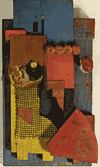The Dada Movement
 The Collages 1
The Collages 1
The domain in which Dada came nearest to fulfilling its promises is undoubtedly the "collage" (which we take in the widest sense of a conglomeration of different materials). The dadaists found their ideal means of expression in the collage, and explored all of its possibilities. Historically, the invention of the collage preceded the beginning of Dada by several years. But there is practically no relation, neither in the conceptual creation nor in the form, between the glued papers of a Picasso, for example, and the unconstituted syntheses of a Schwitters; not more than between the orphic, descriptive collages of a Carrà and the incredible collisions of incompatible labels which were the sign of Max Ernst's arrival at the oniric firmament of the future French surrealists. To be honest, no group, neither before nor after Dada, ever took greater advantage of the resources of this new technique.
The majority of the great dadaists exploited the collage in keeping with their personal temperament; and this procedure, apparently so impersonal and disincarnate, can identify its author quite as exactly as the pen or the brush. The compositions done in Zurich by Hans Arp in 1915 are a reflection of the luminous soul, the serenity, the elegance and the underlying humour of the Alsacian painter; the moustache added by Duchamp to his reproduction of the Mona Lisa (L.H.O.O.Q.), turned this painting into the epitome of the dadaist work of art, but at the same time it revealed the calm aggressivity of a man who carried economy of means to the level of a dogma. At the other extreme was his complete opposite, his colleague Picabia the Spaniard, a joking cameleon who reveals himself in La Femme aux allumettes (1920) or in the satirical Midi, made of feathers and pieces of bamboo. Without knowing the craggy face and the guttural voice of Raoul Hausmann, one can easily imagine him by regarding his Berlin assemblages. On the other hand the "retouched" painted papers of Baargeld and Ernst (Le Roi rouge, 1920) are characteristic of the freedom of spirit of the Cologne dadaists; just as Schwitters' works attest to the obsessional character that this new plastic language had taken on for him.
This brief analysis of the collage is only one example out of a hundred of the extraordinary appetite for invention common to all the dadaists. In contrast with certain great painters, satisfied with having discovered and imposed their style, but unable thereafter to go off on another tack, Duchamp and his followers made a point of regularly creating something new. Dada hates repetition which breeds taste.
1. Kurt Schwitters : Merz. Construction 1921. Philadelphia Museum of Art. A.E. Gallatin Collection.